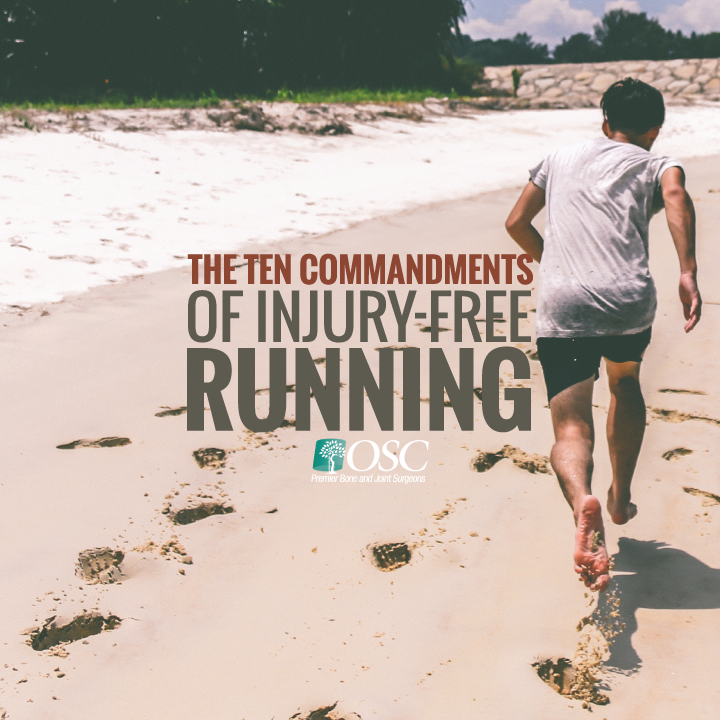
Spring is finally here in Spokane – the long awaited time of year when the city begins to come alive and the running trails are fresh with the scent of lilacs and flowering trees. It’s no wonder that spring is when it’s easiest to overdo the distance and intensity of our first runs. Wanting to go further is all part of the reason that running can be so therapeutic and the reason that many of us start running in the first place, but too much of anything is never good. That’s why it’s important to take time to build up to a certain fitness level before attempting greater distances and intensities. Fortunately, there are rules to follow that can keep you running strong all throughout the year. By taking time to listen to your body now and heed the warning signs of pending running injuries, you can have a healthy stride from Bloomsday, all the way to the last race of fall.
Here are ten simple rules to follow during your training: The Ten Commandments of Injury-Free Running.
1. Know Your Boundaries
Many runners refer to the most common cause of injury as “the Terrible Too’s” – doing too much, too soon, too fast. Almost all running injuries happen when we aren’t sure of our body’s limits. As Irene Davis, Ph.D.from the University of Delaware’s Running Injury Clinic says, “I firmly believe that every runner has an injury threshold. Your threshold could be at 10 miles a week, or 100, but once you exceed it, you get injured.”
For those eager to avoid injury and not put their limits to the test, there’s a way to increase your mileage safely. It’s called the 10 percent rule.
The 10 percent rule is simply adding 10 percent of your current total weekly mileage onto each consecutive week. For example, if you run 10 miles per week comfortably and want to increase the number or miles that you run each week, run no more than 11 miles the next week.
Although this method is reported to have a 97 percent success rate in tests, there is still the chance that it could be too much for your body.
Which is why the next rule is so important.
2. Listen to Your Body
Most running injuries don’t just appear. They are developed over repetition and when they start to happen, there are warning signs – aches, soreness, tinges of pain – like lights on the dash of your car when something needs attention.
When these signs begin to happen, stop!
When you chose to run through the pain instead of stopping, you end up prolonging and complicating the injury.
After stopping at the first sign of pain, take three days off of your routine. On the fourth day, divide your current base mileage in half and run that distance with less intensity.
For example, if you run four miles at eight minutes per mile, run two miles at about ten minutes per mile.
If you can accomplish this pain-free, excellent. Take another day off and then start gradually building back into your former mileage.
3. Shorten Your Stride
Running with longer strides can put extra stress on the joints and increase your chance of injury.
“When you decrease your stride by as little as ten percent, you can reduce the risk of tibial stress fracture by three to six percent,” says biomechanist Alan Hreljac, Ph.D.
It may take some practice getting used to changing your gait, so start small, using a distance like a quarter of a mile, and begin to focus on making smaller strides.
Some runners with chronic injuries may need to have their gait analyzed to see exactly where the problem is happening. (see Gait Analysis)
4. Strength Training
“Healthy running should be as symmetrical and fluid as possible,” says Michael Fredericson, M.D., associate professor of sports medicine at Stanford University School of Medicine. “If you don’t have muscle balance, then you lose the symmetry, and that’s when you start having problems.”
When you add muscle to your body, specifically hip, leg muscle, stability increases everywhere.
According to Dr. Reed Ferber, “strengthening the hips is optimal for effective rehabilitation, as opposed to treating the area where the pain is located.”
If you don’t already have a strength training routine in place, you may want to consider adding one right away.
5. Use the RICE Method
If you’re unfamiliar with RICE, it’s the acronym that has become standard for immediate injury prevention and treatment. Think of RICE as the 911 emergency treatment for a developing injury.
It stands for Rest, Ice, Compression and Elevation.
RICE is extremely effective for minor injuries such as a sprained or twisted ankles.
After an injury, immediately Rest from running for several days depending on the severity of the injury.
Apply ice 10-15 minutes at a time, several times a day, to reduce inflammation.
A compression bandage can also be a great way to fight inflammation and provide pain relief during recovery.
Elevation is also key to speed the recovery process, as it will increase blood flow to the affected area.
6. Run on a Level Surface
Running is all about repetition. On any given run, you take thousands of steps, and over time, those steps can lead to an injury if something is off balance.
If you run along a road that has a slight slant, eventually, the small variance of height from one foot to the other can take a toll, causing a hip injury.
If you’re a high-mileage runner, or are wanting to increase your mileage over time, consider running on a treadmill or track for a few of your runs instead of the open road or trail every single time.
Running on a level surface for a run or two each week should give your body a chance to recover and correct any pending injuries developing from overuse.
7. Don’t Race or Do Speedwork too Often
When you race or push your body to the limit during speedwork, it takes a toll. Even Olympic gold medalists only do a small percentage of their training at full intensity.
Keep speed training to no more than one day a week and after each race, be sure to take one day off per mile that you ran.
If you have a chronic returning injury or injure easily, consider getting rid of speed training altogether. The amount of speed that you might gain through training may not be worth the extra risk of injury.
Evaluate your goals and decide if the extra toll on your body and your recovery is worth the risk.
8. Stretch the Back Of Your Legs
It comes as no surprise that runners are often injured in the places where their muscles and tendons are the tightest. This is often the back of the legs, particularly the calves and hamstrings.
Instead of doing basic static stretches (standing still and holding a stretch), do dynamic stretches (stretches as a part of a movement) as part of your warm up. Studies show that dynamic stretches are more effective for tight muscles in runners.
Also, keep in mind that stretching doesn’t prevent overuse injuries, but works best for increasing range of motion, which can decrease the likelihood of strains and strains during runs.
9. Cross-Training
When running, each stride can put the stress of two to three times your bodyweight on your joints and connective tissues as they absorb the impact of your weight.
In order to keep your current cardiovascular fitness level without hurting your joints, consider adding another routine into your workouts.
Swimming is often the first choice for runners because it’s a great way to keep the intensity of your workout without putting more stress on your joints.
Biking and elliptical machines can also be effective at keeping your heart rate up without any risk of injury.
10. Get Shoes that Fit
Every runner’s foot is different, so there is no perfect shoe that will work for everyone. However, finding the right shoe that fits your foot best can go a long way in preventing and offering support for certain injuries.
J. D. Denton, the owner and operator at Fleet Feet in Davis, CA, recommends always buying less shoe as opposed to more shoe as a general rule, and when buying your shoes from a sales representative, don’t be afraid to ask, “why is this shoe the best fit for me?” If they can’t answer your question, find another store.
Time to Start Running
Although understanding injury prevention is paramount to running safely for a lifetime, there are also many resources to take advantage of if you’re already injured or feel that you are prone to a specific recurring injury.
At OSC, we are more than equipped to deal with all your running needs. In addition to highly trained surgeons and physical therapists, we have a state of the art gait analysis system that can track your movements to tell where your specific problems are occurring in your stride.
Don’t hesitate to schedule an appointment today and get started out on the right foot toward your running and racing goals!
